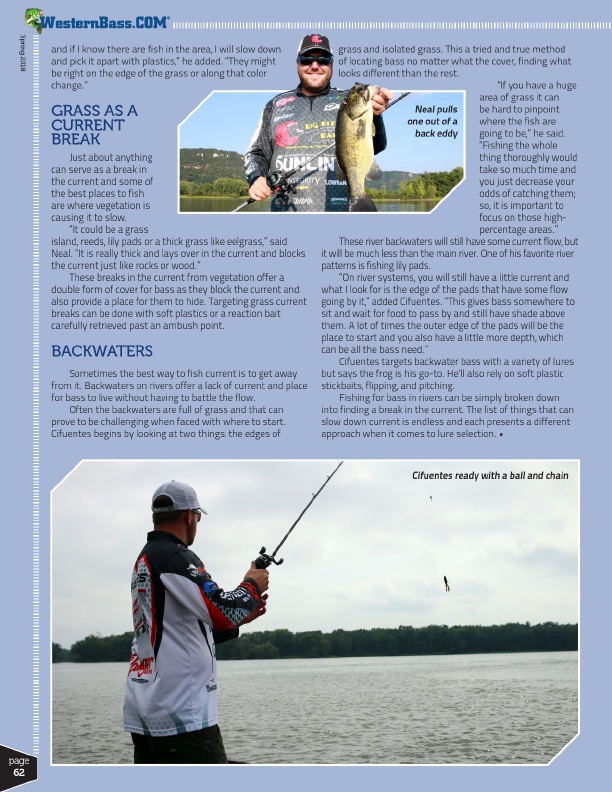
Spring 2018
®
and if I know there are fish in the area, I will slow down and pick it apart with plastics,” he added. “They might be right on the edge of the grass or along that color change.”
GRASS AS A CURRENT BREAK
Just about anything can serve as a break in the current and some of the best places to fish are where vegetation is causing it to slow.
“It could be a grass island, reeds, lily pads or a thick grass like eelgrass,” said Neal. “It is really thick and lays over in the current and blocks the current just like rocks or wood.”
These breaks in the current from vegetation offer a double form of cover for bass as they block the current and also provide a place for them to hide. Targeting grass current breaks can be done with soft plastics or a reaction bait carefully retrieved past an ambush point.
BACKWATERS
Sometimes the best way to fish current is to get away from it. Backwaters on rivers offer a lack of current and place for bass to live without having to battle the flow.
Often the backwaters are full of grass and that can prove to be challenging when faced with where to start. Cifuentes begins by looking at two things: the edges of
grass and isolated grass. This a tried and true method
of locating bass no matter what the cover, finding what
looks different than the rest.
“If you have a huge
area of grass it can
Neal pulls be hard to pinpoint
one out of a where the fish are
back eddy going to be,” he said.
“Fishing the whole
thing thoroughly would
take so much time and
you just decrease your
odds of catching them;
so, it is important to
focus on those high-
percentage areas.”
These river backwaters will still have some current flow, but it will be much less than the main river. One of his favorite river patterns is fishing lily pads.
“On river systems, you will still have a little current and what I look for is the edge of the pads that have some flow going by it,” added Cifuentes. “This gives bass somewhere to sit and wait for food to pass by and still have shade above them. A lot of times the outer edge of the pads will be the place to start and you also have a little more depth, which can be all the bass need.”
Cifuentes targets backwater bass with a variety of lures but says the frog is his go-to. He’ll also rely on soft plastic stickbaits, flipping, and pitching.
Fishing for bass in rivers can be simply broken down into finding a break in the current. The list of things that can slow down current is endless and each presents a different approach when it comes to lure selection. •
Cifuentes ready with a ball and chain
page 62